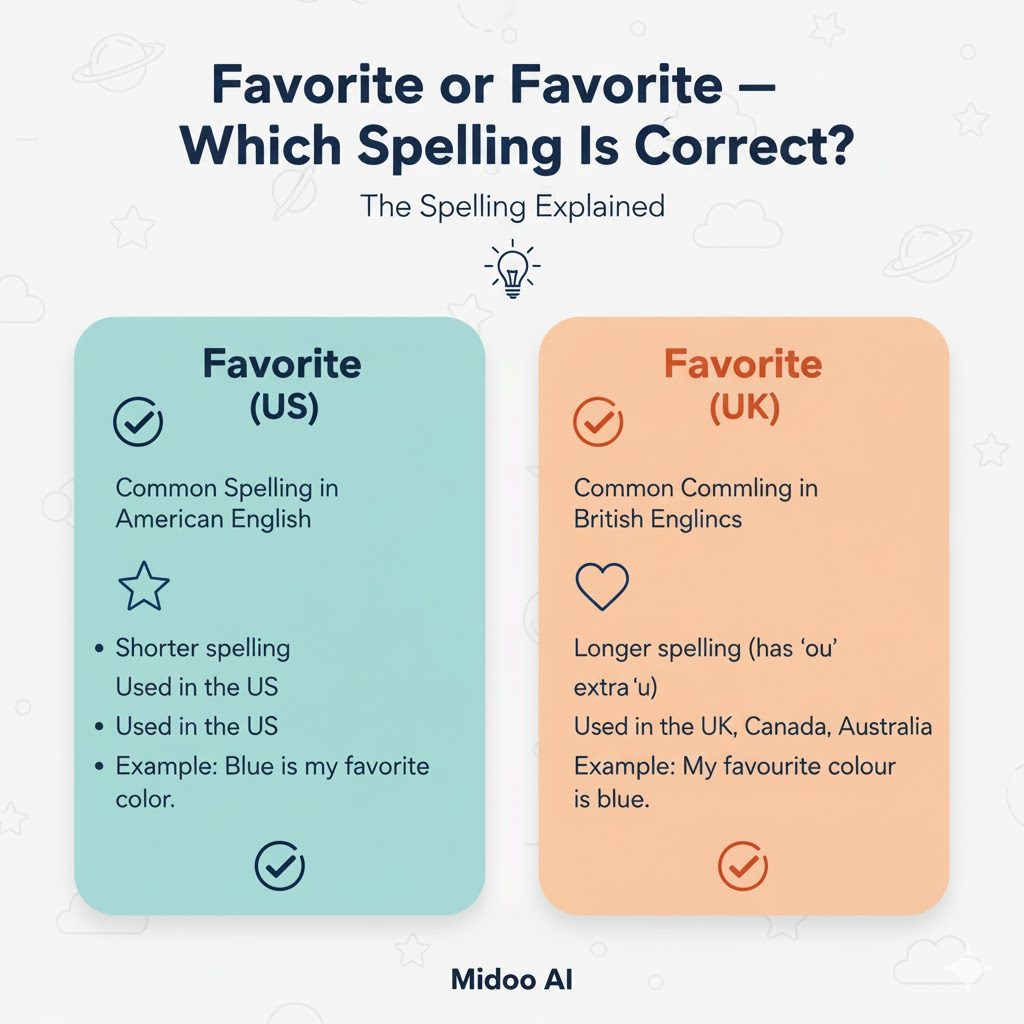Favorite or Favourite — Which Spelling Is Correct?

English spelling can be tricky, especially when a single extra letter separates two perfectly correct words. One of the most common confusions learners face is whether to write “favorite” or “favourite.”
Both are right — but your choice depends on where and for whom you’re writing. In this guide, Midoo AI explains the difference between these two spellings, when to use each, and how to remember them effortlessly.
1. The Core Difference
Simply put:
- Favorite → Standard spelling in American English.
- Favourite → Standard spelling in British English (and countries that follow it, like Canada, Australia, and the U.K.).
The meaning, pronunciation, and grammatical usage are exactly the same. The only difference lies in spelling preference — that extra “u” makes it British.
2. Why the Difference Exists
The spelling difference between favorite and favourite comes from Noah Webster, the American lexicographer who simplified many English words in the 19th century.
He believed English spelling should reflect pronunciation more clearly. So, words like:
- colour → color
- honour → honor
- favour → favor
followed a shorter, more phonetic pattern in the U.S.
Since “favorite” is derived from favour + ite, Americans naturally dropped the “u,” while the British retained the traditional French-influenced spelling “favourite.”
3. How Each Is Used in Sentences
🇺🇸 American English: “Favorite”
Pizza is my favorite food.
What’s your favorite movie?
That’s my favorite place to relax after work.
She wore her favorite pair of shoes to the party.
This is one of my favorite songs from the 90s.
✅ Tip (U.S.): If your audience is American or global (especially on the internet), stick with favorite — it’s recognized worldwide and rarely marked as incorrect.
🇬🇧 British English: “Favourite”
Football is his favourite sport.
London is my favourite city in the world.
That’s my favourite café in the neighbourhood.
She received her favourite flowers for her birthday.
Reading in the park is one of my favourite weekend activities.
✅ Tip (U.K.): Use favourite when writing for British, Canadian, or Australian audiences, or for exams like IELTS that follow British spelling.
4. Quick Comparison Table
| Context | American English | British English |
|---|---|---|
| Everyday writing | Favorite | Favourite |
| Formal documents | Favorite | Favourite |
| Online / global audience | Favorite | Favourite (optional) |
| IELTS or academic writing (U.K.) | — | Favourite |
5. Common Mistakes to Avoid
❌ She’s my favourite actress. (wrong in U.S. English)
✅ She’s my favorite actress.
❌ My favorite colour is blue. (wrong in British English)
✅ My favourite colour is blue.
💡 Tip: Always check your system’s language setting — spell checkers in Word or Google Docs will auto-correct based on the region you’ve selected.
6. How to Remember the Difference
Midoo AI suggests a simple memory trick:
- Favorite (no “u”) → U.S.
→ “U” is missing, just like in “United States.” - Favourite (with “u”) → U.K.
→ Think of “U” for “United Kingdom.”
So if you’re writing for U.S. readers, skip the “u.”
If you’re writing for British readers, include it proudly.
7. Real-Life Usage Examples
| Sentence | Region |
|---|---|
| “Chocolate is my favorite dessert.” | 🇺🇸 American English |
| “Chocolate is my favourite dessert.” | 🇬🇧 British English |
| “Her favorite color is green.” | 🇺🇸 American English |
| “Her favourite colour is green.” | 🇬🇧 British English |
| “That’s my favorite TV show right now.” | 🇺🇸 |
| “That’s my favourite TV programme right now.” | 🇬🇧 |
Tip from Midoo AI
When you use Midoo AI’s writing assistant, it automatically detects your dialect preference.
If you select “American English,” it will use favorite, color, and honor.
If you switch to “British English,” it will replace them with favourite, colour, and honour.
This ensures your writing stays consistent and natural across all contexts — whether it’s for a U.S. blog, a U.K. resume, or a global website.
FAQs
Q1: Is “favorite” wrong in the U.K.?
No. It’s not wrong, but it’s non-standard. British readers will recognize it but may see it as American style.
Q2: Which spelling should I use for international readers?
Use favorite. It’s more widely accepted online and by international English learners.
Q3: What do Canadians use?
Most Canadians prefer favourite, following British English, though “favorite” appears in some media or software contexts.
Q4: What about formal writing or job applications?
Match your spelling to your audience. If applying to a U.S. company — use favorite. For a U.K. or Australian company — use favourite.
Q5: Why does Midoo AI care about this difference?
Because spelling consistency affects readability, tone, and even search optimization. Midoo AI helps you stay regionally correct so your English feels natural, not mixed.
Final Tip from Midoo AI
Both favorite and favourite mean the same thing — something or someone you like the most.
The difference lies in spelling style, not meaning.
American English → favorite (no “u”)
British English → favourite (with “u”)
Whichever you choose, stay consistent — and let Midoo AI help you adapt seamlessly to your readers’ expectations.